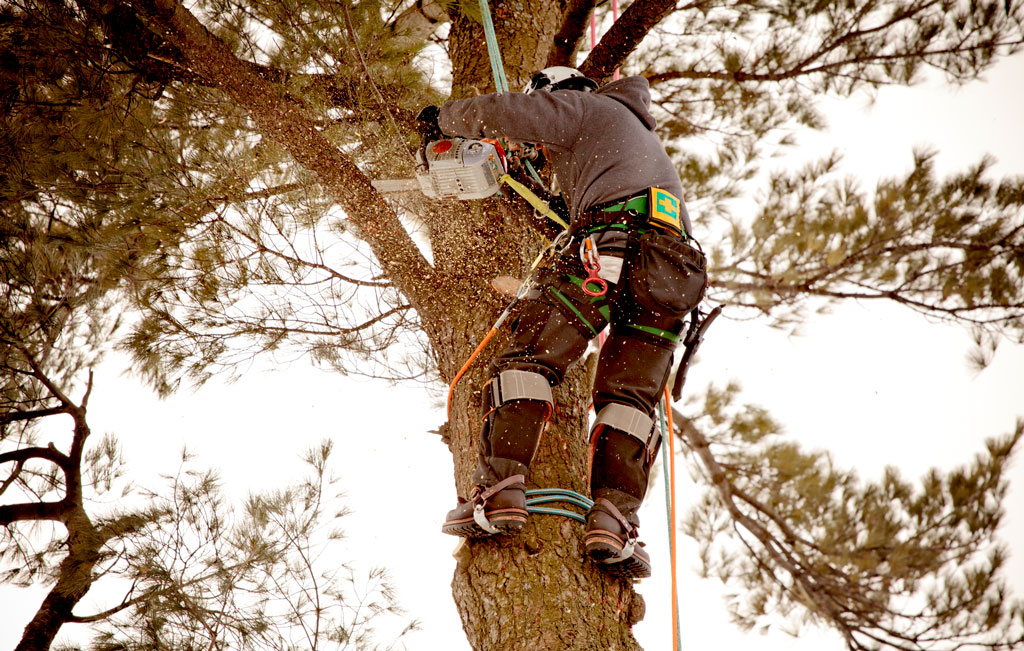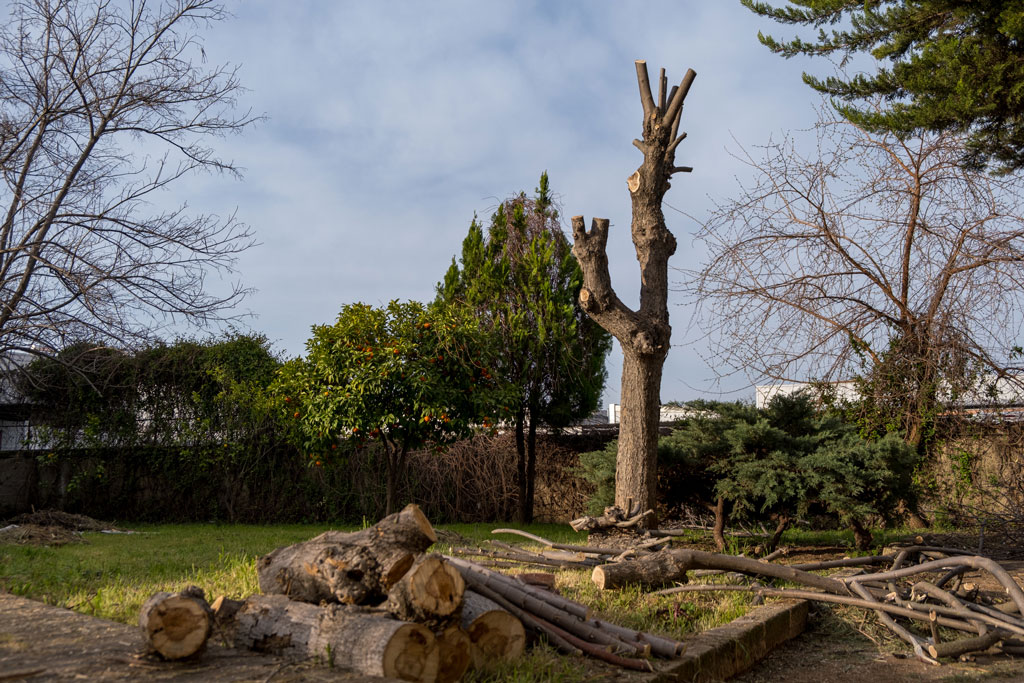Benefits Of Regular Tree Trimming Service
Regular tree trimming service can keep your entire landscape looking great and healthier than ever before. At S&P Tree Service, we’re proud to discuss any of our services and how they can benefit your property. From cutting back overgrown branches to improving the soil base, we have you covered. In the meantime, find out the main reasons customers opt for trimming as part of their arbor care.
Top Tree Trimming Benefits
There are many reasons it makes sense to keep your trees trim and slim. It can boost your property values and make it easier for sunlight to reach flowers and grass nestled underneath them. Find out other reasons it makes sense to invest in arbor care for your landscape. For example, you can save money and increase your curb appeal with regular tree trimming.
Instant Equity Boost
Having picture-perfect trees can increase your property values significantly. They provide shade and add character to your Victorian Manor or ranch-style home. So, if you’re looking to sell your home in the next few years, it pays to maintain your tree inventory appropriately. Pruning and trimming are a big part of this equation.
Keeps Your Trees Healthy Longer
Trimming your trees can boost their overall health. On the other hand, dead or damaged branches can prevent other parts of the tree from developing normally. They also serve as a dinner invitation for pests that love to chow down on trees. In order to prevent diseases, you need to stimulate growth with regular trimming and pruning. Plus, reducing the weight of the branches can prevent damage that occurs during storms.
Trees have a huge surface area compared to other living things. This can leave them susceptible to weak points that lead to hazardous conditions for passersby. When you trim your tree regularly, it strengthens your tree’s structure and limits your liability.
Pretty Trees are Well-Trimmed Trees
When you trim your trees, you boost the appearance of your entire landscape. Add beauty and charm to your backyard or estate by creating a uniform look or giving each tree a unique flair. Nothing ruins a well-manicured lawn faster than unruly trees with branches growing in every direction, blocking sunlight from your flowers and ornamental plants as well as your garden vegetables.
Here Comes the Sun
While trees provide comfortable shade, you don’t want them to block all the sunlight from your yard. That’s exactly what can happen if you don’t regularly prune your trees. Contact the experts at S&P Tree Service to fully understand the benefits of increasing air circulation with judicious trimming. Your grass and plants will thank you for more ideal growing conditions.
Dense overgrowth can make it harder for the other greenery in your yard to thrive. Therefore, it’s important to include trimming in your overall landscape management strategy. Don’t worry; our experienced tree specialists will handle this for you.
Improves Safety
When you partner with our team to regularly trim your trees, you can increase the safety of your kids, neighbors, and guests. Falling branches can land on cars, sidewalks, and people, increasing your liability. So, to keep the people you care about safe, it’s important to trim branches back before they become a hazard.
Irregular growth or die-off can cause one side of the tree to develop more than the other. This could make it top-heavy or cause it to lean over. In order to prevent this undesirable outcome, we recommend helping your tree maintain its balance with timely tree trimming service.
Bye, Bye Tree Disease
Tree trimming service in itself cannot prevent the spread of diseases from tree to tree. However, trimming back branches leaves more space between trees and makes it easier to spot infected branches. Protect your tree and other flora in your yard with proper tree care, including trimming services.
You can also prevent pests from boring into and gnawing on the tender parts of your tree. Borers and beetles enter through openings in the bark. When you remove damaged branches, you limit entry points for unwanted guests.
Shapes Up Your Trees
Although trees do not require exercise as people do, there are still ways to help your elms, oaks, and maples stay in shape. When you prune overgrown trees, you can prevent them from becoming nuisances. When trees grow odd shapes and sizes, they often have to be cut back or completely removed to avoid safety issues. However, it’s easy to prevent this with regular trimming.
Partner with a local common knowledgeable arbor care company such as S&P Tree Services for the best results when it comes to preventing crowded canopies that reduce the beauty of your landscape.
Encourages New Growth
Healthy trees produce new shoots that need sunlight to grow and develop properly. If you don’t remove dead and diseased branches, you might stunt the tree’s growth process. This could lead to problems with branch and leaf growth over time.
With the right tree service company, you don’t have to lift a finger to create a balanced and visually appealing treescape on your residential or commercial property.
Greener Trees Could Equal Greener Pockets
Regular trimming reduces the need for tree removal, which is typically more expensive. Preserve your budget and your ornamental trees with regular trimming. Left unchecked, trees can encroach on nearby structures, which could lead to costly repairs.
For peace of mind, it’s essential to slim down trees with overgrown branches at least once a year. We can inspect all the trees on your property to determine which ones require trimming and provide a quote for tree trimming that can resolve the issue quickly.
Contact S&P Tree Service to schedule a free consultation for tree trimming service today!
See our most recent blog on this topic here.
Check out our reviews here.
Photo By vtwinpixel at iStock
When Is Tree Removal Service Necessary?
In the ideal world, you would not have to remove a beautiful, older tree that has been a part of your home’s landscape for years. Yet, there are times when it is necessary to get rid of the tree. Using a licensed, insured tree removal service is the best way to do so, as it can help to minimize risks to you and your family as well as to your yard, home, and your neighbor’s property. How do you know when you need full tree removal, though? It is not always an easy decision.
The Tree is Damaged or Decaying
One of the most important times to remove a tree is when it has significant damage to it, such as from a lightning strike. When this happens, it creates a safety concern for the tree. In the long term, you may have a tree that is likely to fall over in a storm. The same applies to decay. You may not notice it initially, but over time, decay from the inside out leaves a tree very vulnerable to damage. A strong wind storm puts you at risk in these situations of having a tree that topples to the ground.
The Tree is Hollow
Over time, damaged and decayed trees will become hollow. Sometimes this occurs as a result of decay brought on by termites. No matter the cause, without the strong interior to support it, this hollow tree is at a higher risk of toppling over and putting other property and people at risk as well. Hollowed trees are unable to sustain themselves and eventually will succumb. They also become one of the worst locations for pesky critters to hide in them, calling your property their home.
There are Numerous Dead Branches
Though it can be hard to see initially, over time, you may notice that the tree has more and more branches that don’t have leaves. They may seem brittle and frail as well. This could be a sign of disease. You can have a tree removal service just remove those branches, and in some cases, that may enable you to save the tree itself. However, if there is disease, you risk it spreading to other branches as well as to other trees on your property, amplifying the problem.
The Location is Hazardous
There are some situations where the location of the trees themselves is a problem. For example, the tree may be growing towards your home, putting a risk on the actual structure. Not only does this occur when there’s evidence of the tree’s branches striking the home or the trunk growing too close to the structure, but there’s also the risk of root damage.
Roots can move through the soil under your home at significant depths. You cannot see this from above the surface, but as they search for water and nutrients, the roots will push into and around anything in the way. That puts your home’s foundation and pipes all at risk. The only way to prevent further damage brought on by these problems is to remove the tree.
Insect Damage is Extensive
Removing a tree due to insect damage is sometimes necessary, especially if the infestation cannot be controlled in any other way. Remember, those insects may be causing damage to your tree, but they are also putting your home’s wooden structure, other trees nearby, and your home’s roof at risk. The bottom line is that if there is a significant insect infestation in the tree, getting rid of the tree itself may be critical in protecting your home over the long term.
A New Lean is Happening
Your tree may seem healthy and normal. Yet, over time, you notice it seems to be leaning more and more. Leaning isn’t a good thing. It means the tree’s roots are very shallow, and that puts you at risk of the tree falling over eventually.
If the lean has always been there, that could be just the way the tree grew. However, if it is new or it is worsening, it is best to have a professional take a closer look at the tree’s root structure and overall integrity to ensure it’s going to be safe to keep it there. If not, removing the tree becomes a priority before it falls over on its own.
Fungal Disease Growing
You should also consider a tree removal service when you have a tree that has a fungal disease on it. Unfortunately, in some areas, this is a growing problem, and like with other conditions, if you do not treat it now, it could spread to other trees and put your property at risk.
There are some situations where a fungal disease can be treated. You can always work with an arborist who can provide you with insight into whether this could be beneficial to you, but there is often a cost and time demand for this type of work. For some people, the benefit of removing the tree is necessary.
Should You Remove a Tree Because You Do Not Like It?
You have the right to make decisions about the trees on your property. If there is a tree that is in the way of the way you wish to use your property, then removing it could be the ideal decision for you. The first step is always to have a professional inspect the tree to give you a good idea of what to expect, including how challenging the process could be. For larger trees, this can prove to be vital.
Working with the Right Team Matters
As you consider the need for tree removal service, know who to call, a company with years of experience and a reputation for ensuring the work is done properly and safely. Contact our professionals at S&P Tree Service to learn more about the options for removing any type of tree from your property. You will get a fair price and an accurate quote when you give us a call.
See our most recent blog on this topic here.
Photo By ahmet rauf Ozkul at iStock
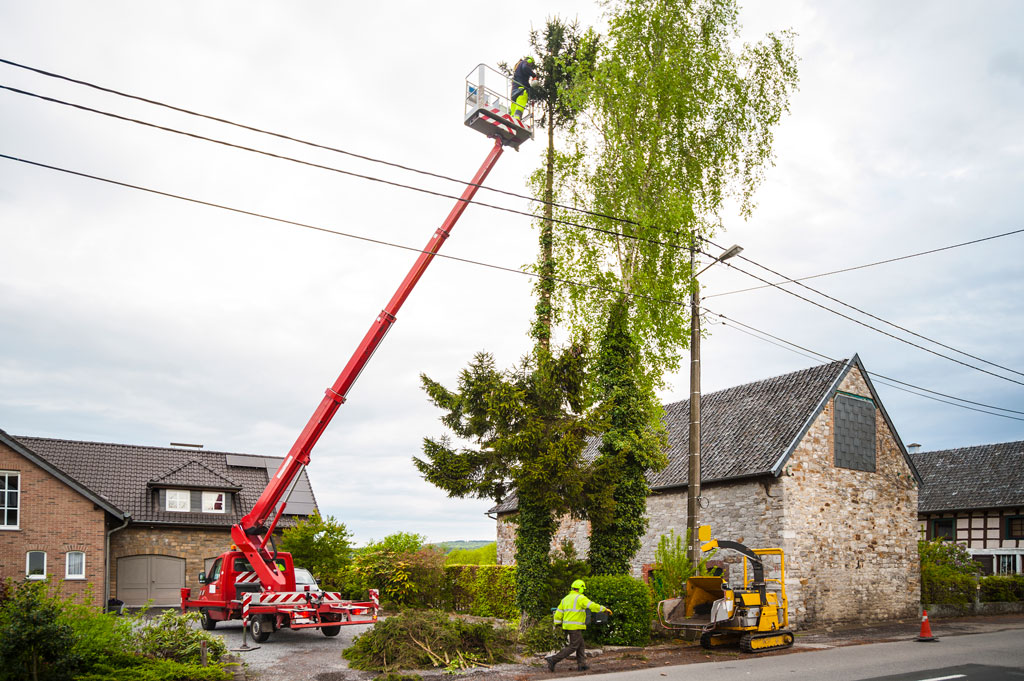
A New Industry Standard: Crane Tree Removal Service
Many tree care companies offer removal services, but there’s often a better way for taking down trees. At S&P Tree Service, we specialize in crane removals because the use of cranes have revolutionized our industry, creating a new industry standard for the safe removal of large and hard-to-access trees. Although we still have loads of chainsaws and employ many traditional techniques for felling trees in some situations, we favor the use of tree cranes for many situations. Our arborists and crews also offer tree preservation, tree trimming, and stump grinding services. Rely on our team for all of your tree care and tree removal needs.
Why Cranes?
Cranes have been incorporated into the tree care industry because they can enhance safety and efficiency–especially when it comes to the removal process. Our crane tree removal service favors cranes for tree removals when the tree is located in a busy part of town and is situated close to homes or businesses. Removing trees with saws and ladders involves greater risk for crews as well as for property. One false move and a limb could fall on a house or fence or it might harm someone.
Cranes remove much of the risk because they handle the heavy lifting. Crane tree removal service involves a top-down method for removal. Each section about to be removed is first tethered to the crane with harnesses and cables. Only when it’s secure is the piece sawed away. Then, the crane lifts it and places it on the ground.
What Should You Look for in a Tree Care / Removal Company?
When searching for a company that offers crane tree removal service, you should be sure that it is licensed and insured. Our company is, and we feature, certified arborists, experienced crews, and highly trained crane operators. Some contractors may offer removal services but are not tree experts. Don’t compromise the safety of your property by hiring untrained operators. We have proven expertise and a record of safe tree removals.
When hiring a tree care company for your tree removal, you should choose a company that owns its own equipment, including its cranes. Some contractors may rent cranes, but that doesn’t make them experts in crane operation. Cranes only make tree removals safer when they are operated by experienced tree crane professionals. We own our own cranes and equipment, so we can be completely sure of their top quality and excellent maintenance.
Our company also offers emergency tree removals. We can handle trees of all shapes and sizes, even if they’re in precarious circumstances, such as leaning or severely diseased. Be sure that any contractor you hire is able to tackle the types of trees on your property.
When Should You Use a Crane to Remove a Tree?
Crane removals have become an industry standard when the tree in question is large or in a hard-to-access location. Large trees can take days to cut down with just saws and climbers. The process can be cumbersome and dangerous. Cranes are able to remove larger, heavier portions of trees and do not simply allow them to fall to the ground. The crane lifts and removes heavy tree limbs, ensuring that the process is a safe and efficient one.
Cranes make the removal process more efficient. Although it may take most of a day to remove a large tree, the process can be completed in a single day. Removing a tree by old-fashioned means could take a few days.
When are Other Removal Methods Used?
Trees that are severely diseased and unstable often need other solutions in addition to cranes. They may need cabling to keep them stable so that climbers and cutters can access them. When we evaluate a tree, we take its condition into careful consideration. If the tree is damaged, diseased, or dead, it may be too unsafe to administer our normal removal processes. We can create a specific removal plan using techniques that are ideal for your specific tree. When you consult with our company, you can rely on our tree experts throughout the removal process.
Tree Removals and Cranes
When you hire us for crane tree removal service, we start, as mentioned, with a tree evaluation. Our arborists will inspect the tree and its immediate location. Factors associated with the tree will necessarily direct the process we use. If the tree is a candidate for crane removal, we’ll schedule a date to bring our crane and crews to tackle the job.
We will arrive with the equipment needed for each aspect of your tree removal. To begin, we park and set up our crane, ensuring that it’s perfectly level for the operation. The crane needs level ground to operate safely. When the crane is set up, we’ll begin the removal. Generally, the crane operator will place the climber/cutter into the treetop. The cutter harnesses the section that will be cut away first. Once the section is secure, the cutter will see it away, allowing the crane to lift it to the ground.
After the first section is removed, the cutter and crane operator repeats the process over and over again until the tree comes down completely. We can also provide stump grinding. The crews who work on the ground during the removal process cut the sections of the tree into smaller pieces that are easier to move. We load them onto our trucks and haul them away, leaving your landscape tree debris free.
Call us if you need any type of tree removed from your landscape. We serve commercial and residential customers.
Customers trust us because of our reputation for expertise, experience, and fair pricing. Get in touch with S&P Tree Service if you have questions or want to schedule a tree care service.
Be sure to read our next blog on the topic.
Photo By tibu at iStock
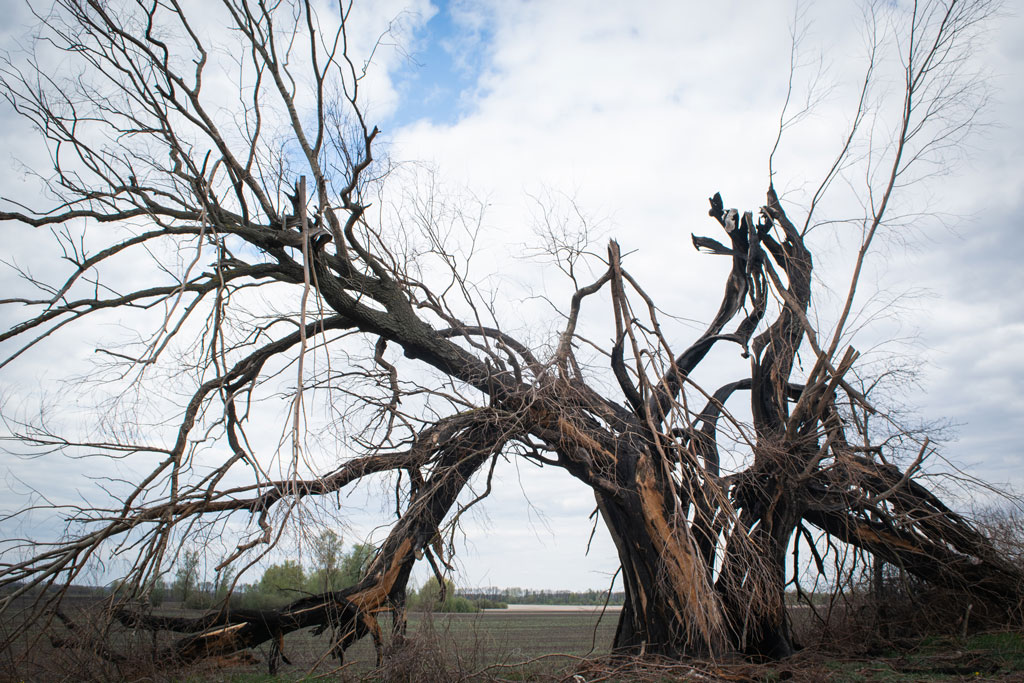
Problems That Demand Emergency Tree Service
How often do you inspect the trees on your property? It’s a good idea to check them frequently because while some problems are easy to spot, others might be less noticeable until they’re too major to ignore. S&P Tree Service features a full range of tree care services, including addressing tree emergencies. Storms, pests, and even age can lead to emergencies that require the services of tree care specialists. There are many types of tree emergencies, and we tackle them all! If you need tree service, whether preservation, trimming, or removal, we can help.
Tree Branches Near Cables
Storms or powerful winds can break or damage tree limbs, causing them to brush against cables. Often, a damaged limb is at risk of breaking off and then falling onto cables. You may need emergency tree service to remove damaged tree limbs or even the tree itself if it begins to lean, threatening to fall onto tree limbs. Our technicians will arrive to inspect the tree’s problem. We can take the ideal measures to make your landscape safe again.
Leaning
If a tree begins to lean, it’s crucial to inspect it. If a tree leans too precariously, it will likely need to be removed. Tree technicians can sometimes stake trees and help them to right themselves, but this is often most easily accomplished with young trees. If the tree is larger, removal might be recommended.
Trees can lean for many different reasons. The roots might be suffering from a condition known as root rot, which usually results in the tree’s death. Before killing the tree, the disease can cause roots to wither, leaving the tree at great risk of toppling over. If the tree starts to lean, it’s a sign that it could fall. Leaning trees should always be investigated. If a storm causes a tree to suddenly start to lean, you’ll need emergency tree service.
Tree Cavities
Tree cavities, hollow holes in the tree’s trunk, a sign that there’s a problem. The tree may be severely diseased or even dead. A dead or dying tree is at great risk for dropping branches and limbs that can damage property and injure people and pets. A dead tree is actually enduring the decaying process, which means that it can drop limbs or even topple over at virtually any time. If you spot tree cavities, call us to inspect them. If the tree is diseased, it may be possible to save it with our tree preservation techniques, but hollow holes in the trunk are often an ominous sign.
Tree is Losing Foliage
If your tree loses its foliage, you might need a prompt inspection service. There’s likely a serious problem, so you’ll need a knowledgeable arborist to investigate. Like other plants, trees may need maintenance like preservation services. As trees age, they can become more vulnerable to tree disease. We can let you know the state of your tree’s condition, determining when a removal is necessary to preserve the safety of your property.
Pest Infestation
If pests are infesting your tree, you might need emergency tree service. Our team includes certified arborists. We can visit your landscape to quickly determine what pests are infesting your tree or trees. Often, the pests can be combated, but some pests signal that disease is present and spreading. Dutch Elm disease, for instance, is spread by pests. In order to combat the contagion, tree removal may require removal.
Fungus
Is your tree plagued by fungus? Fungal diseases can kill a tree slowly or fast, depending on what type of disease is present. Our arborists can often save a tree with timely intervention. Strategic tree pruning allows us to remove diseased limbs, preventing the pathogens from spreading. If the infection affects the roots, there’s a strong possibility that emergency removal is needed. When the roots are affected by the disease, the tree can quickly become unstable–and unsavable. Sick trees are property liabilities. Let our arborists inspect signs of tree fungus to determine what the safest course of action is.
Storm Damage
Texas storms can be extremely powerful. During any given storm, trees get damaged by winds and lightning strikes. The damage may be minor or could be extensive. Our arborists can inspect the storm damage and provide emergency tree service to minimize the damage and, hopefully, save the tree. If the damage is severe, you may need emergency removal, another service we provide.
Caring for Trees Professionally
Our company’s certified arborists are tree experts. We strive to preserve trees, but we also know when removal is essential to support the health of the landscape and its safety. We can provide many preservation services, from caring for sick trees to nurturing their healing after storm damage.
We also have all the equipment and skilled crew members needed to remove trees, no matter their size and condition. When a tree requires emergency removal, it’s always best to hire an experienced tree removal company like ours. Removing trees can be dangerous. Not only are power tools dangerous, but they also become increasingly so when used in a tree.
Dead or dying trees can be unstable. Large trees can be challenging to cut down using traditional methods. This is why we’ve invested in tree cranes. We offer emergency crane service to remove trees from commercial and residential landscapes. Cranes help us more efficiently and safely remove large trees along with trees in hard-to-reach areas.
If you have a tree emergency, call us to inspect it and provide the ideal tree care or tree removal solution.
We have years of experience serving the region with our tree care services. We can help you maintain the health of your trees and the health and beauty of your landscape. Call S&P Tree Service to learn more.
Be sure to read our previous blog on this topic here.
Photo By Jana_Janina at iStock
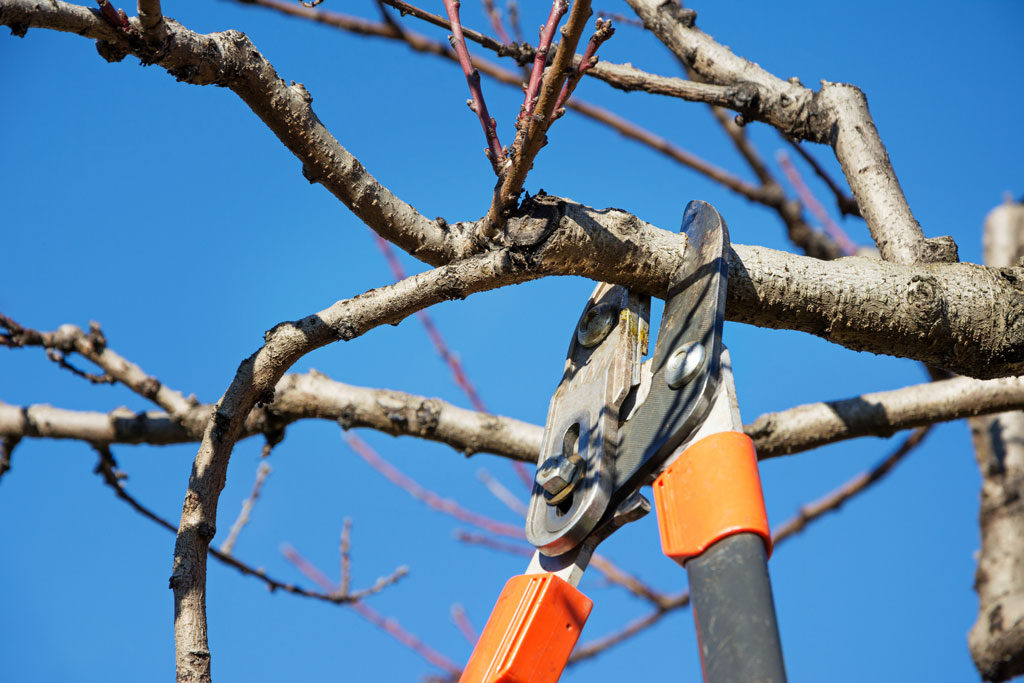
Deadwooding: A Crucial Tree Trimming Service For Your Tree’s Health
Trees in your yard add to the aesthetic value of your property and play an important role in maintaining a healthy ecosystem. To ensure that your trees remain strong and healthy, you need to take proper care of them, including regular maintenance through pruning and trimming. Deadwooding is one crucial tree trimming service that ensures the well-being of your trees by removing dead or decaying branches. This blog post discusses the importance of deadwooding and how it contributes to the overall health of your trees.
What is Deadwooding?
Deadwooding tree trimming service is the process of removing dead or dying branches from a tree. The technique is performed for aesthetic purposes and to prevent accidents caused by weak, dead, or rotting branches. Dead branches look unsightly and can break and fall, causing injury or damage to property. Deadwooding involves the removal of affected branches to prevent further spread of decay or stress to the healthy parts of the tree.
How is Deadwooding Done?
Deadwooding should be done by a professional tree trimming service provider. The process involves identifying the deadwood, removing the infected limbs or branches, pruning any crossing branches or those that may pose a safety risk, and cutting away any stubs left from past cuts. The deadwood is cut back to the branch collar, which is the area where the branch attaches to the trunk. This prevents any unnecessary damage to the tree and helps it heal faster.
Deadwooding Benefits
Improve Tree Health
Dead branches threaten your tree’s overall health by inhibiting essential nutrients from reaching the healthy parts of the tree. Deadwooding can promote the growth of new, healthy branches and improve tree vigor. This pruning method can also prevent the spread of decay and infectious diseases throughout the tree.
Increases Safety
Dead branches can fall anytime, causing injury or damage to property. This is especially true during heavy rains or snowfall. Deadwooding eliminates the risk of a broken branch falling onto pedestrians, cars, or buildings. Deadwooding also keeps the tree structurally sound and aids in preventing it from falling during high winds or storms.
Aesthetic Enhancement
Dead or broken branches can make your tree look unsightly. Eliminating them can improve the tree’s appearance and the overall ambiance of your surroundings. Deadwooding can also enhance the tree’s natural shape and make it look more attractive.
Encourage Fruiting and Flowering
Deadwooding stimulates new growth, which can result in more blossoms and fruit. Dead branches can draw nutrients away from other parts of the tree, including those essential for fruiting and flowering.
Protect Your Property
Deadwooding your trees can protect your property from falling debris. It is a proactive approach to minimize damages resulting from falling branches. This is especially beneficial if you have trees near your home, where fallen branches may cause extensive damage to your roof or other critical components of the house.
Cost-Effective
Deadwooding is an affordable alternative to tree removal. Most tree owners think they must remove the tree once the branches die. However, removing the deadwood can save a tree and prolong its life. Deadwooding can extend your tree’s life, so you won’t have to worry about costly tree removal services.
When Should Deadwooding Be Done?
Late Autumn
Late Autumn is usually the best time to deadwood your trees, mainly deciduous trees. This season, the tree has already lost its leaves and goes dormant, making it easier to identify the dead branches. It’s also safer to perform this task in late Autumn, as pests and infections are not as active during this time. Furthermore, tree services are generally not as busy, meaning you’ll likely get more attention and collaboration from your local arborist.
Early Spring
Early spring is also an excellent time to do deadwooding on your trees, especially in conifers. Before the new growth begins, seeing the dead or diseased branches is easy. Additionally, removing the branches before spring starts helps to prevent pests and infections from spreading fresh wounds. Before pruning, it’s essential to check the weather as well. Pruning during frosty weather is bad since the cold can damage the tree when its leaves or buds haven’t fully developed.
Fall Whispers
Fall whisper is another ideal time to look for deadwood on your trees. After the leaves have dropped, you may get the clearest view of your trees’ structure in this brief stage. Any deadwood on your tree will stand out during this time. This is an ideal time to address issues of safety and functionality by reducing the size of the tree of deadwood, but be cautious of over-pruning or using inexperienced arborists.
Avoid Summer
Summer is, without a doubt, the worst time to deadwood your trees. During this period, the tree is typically in its growth phase, making this season the most vulnerable to infections and pests. Deadwooding in summer also stresses the tree, which may cause damage. The only time to consider pruning in summer is to remove immediate hazards like those caused by storms, such as broken branches that may cause damage to people or property.
Taking care of your trees requires effort and regular attention. By correctly maintaining them, you are ensuring their health and longevity. Deadwooding is one of the essential services in the landcare industry that can prevent the spread of infections and pests and improve the tree’s overall appearance. If you detect any dead or decaying branches in your tree, immediately hire a tree trimming service provider to perform the necessary deadwooding services. You will benefit not only your tree’s health but also the entire ecosystem’s health.
Call Us for Professional Deadwooding
If you need help deadwooding your trees, contact us at S&P Tree Service. We are proud to provide outstanding tree care services throughout the region. Our certified arborists have the knowledge and experience to care for your tree safely and efficiently. Call us today to learn more about our deadwooding services.
See our most recent blog on this topic here.
Photo By ueuaphoto at iStock
Check out this tip!


